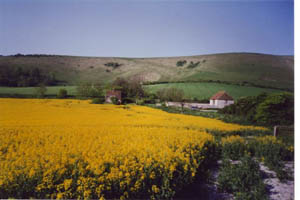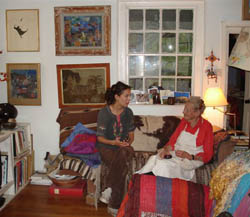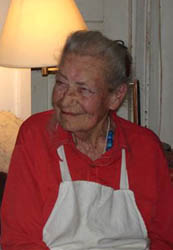Ups and Downs in Sussex
Lewes, Sussex
by Sarah Shuckburgh
From ancient
castles to the Blomsbury set, Lewes and its villages are full of art and
history, says Sarah Shuckburgh.
 Lewes
was recently voted the best place to live in England. The
pretty Georgian town is also a perfect base for a weekend -
with unexpected layers of history, and, in nearby pockets of
the South Downs, literature, art and opera. My grown-up
daughter and I can’t agree about what to see first. Amy - a
passionate painter with a half-written novel - wants to head
straight for Virginia Woolf and Vanessa Bell, but I want to
start in 1066. Lewes
was recently voted the best place to live in England. The
pretty Georgian town is also a perfect base for a weekend -
with unexpected layers of history, and, in nearby pockets of
the South Downs, literature, art and opera. My grown-up
daughter and I can’t agree about what to see first. Amy - a
passionate painter with a half-written novel - wants to head
straight for Virginia Woolf and Vanessa Bell, but I want to
start in 1066.
I win, so it’s Lewes castle first - one of several
fortresses built by William the Conqueror to defend his
route between London and Normandy. William Warenne was its
first feudal lord, and his family ruled Lewes for the next
300 years. We climb the spiral stairs of the castle motte
and emerge high above the town to a tranquil panorama of
rooftops, chalky downs and the winding river Ouse. Reading
the historical notes, I realise that Lewes’ history began
much earlier than the Norman Conquest. The Twittens, a grid
of narrow cobbled alleys where our hotel stands, date from
Saxon times, and there are also Roman remains, and iron age
ramparts.
In the castle museum, we are delighted to find that our
hotel features in the illuminated diorama illustrating the
town’s history. When the model of Pelham House lights up, we
can even spot the turret which contains our bathroom. From
the 16th century, the house was owned by a series of
bigwigs, including four generations of Gorings, all called
George, and then seven generations of Pelhams, several
called Sir Thomas. In the 1930s, it became the headquarters
of East Sussex County Council, but mercifully, the
bureaucrats didn’t rip out the Elizabethan oak panelling,
the stone staircase or the Georgian windows and shutters,
which all survive today in the hotel, with more austere
council chambers and corridors.
 After
lunch, we return to the 16th century, and a rambling
timbered house which Henry VIII gave to Anne of Cleves as
part of her divorce settlement. The Queen never lived here,
but the building has changed remarkably little since her
day. The huge upper floor is our favourite - a sleeping and
living hall with lofty beamed ceiling, dark oak furniture,
tapestries and four-poster bed. We linger in the gloom of
this wonderful room, discussing Tudor divorce and modern
step-families. After
lunch, we return to the 16th century, and a rambling
timbered house which Henry VIII gave to Anne of Cleves as
part of her divorce settlement. The Queen never lived here,
but the building has changed remarkably little since her
day. The huge upper floor is our favourite - a sleeping and
living hall with lofty beamed ceiling, dark oak furniture,
tapestries and four-poster bed. We linger in the gloom of
this wonderful room, discussing Tudor divorce and modern
step-families.
Leaving Lewes, we drive through winding lanes to the village
of Rodmell, where Virginia Woolf spent weekends and holidays
from 1919 until her death in 1941. Woolf called Monk’s House
“unpretending”, and it is indeed modest, with low ceilings
and flagged floors, but it is full of colourful Bloomsbury
art, with furniture and pottery painted by Woolf’s sister
Vanessa Bell, and tapestry chair-backs designed by Duncan
Grant, and stitched by his mother. By the back door, we read
a short story by Virginia Woolf entitled ‘The Garden‘, and
then step into her own paradise of tumbling roses, lily
ponds, fruit trees and beds of shoulder-high perennials. It
is hard to imagine being unhappy in such a beautiful place,
but it was here that Woolf killed herself. Beyond a croquet
lawn is her summer house, with her work table and pencils,
and sepia photographs of the couple’s distinguished literary
and artistic guests.
Amy wants to stay here all afternoon, but it is time for our
next cultural visit. In the Glyndebourne car park, we
quickly doll ourselves up and join hundreds of guests
strolling in the afternoon sunshine. The gentlemen are in
dinner jackets, but no sartorial rules constrain the ladies
- some have apparently raided dressing-up boxes for tiaras,
long gloves and ball gowns, and the rest seem to have
hurried here from the beach, in cut-off trousers, flip-flops
and tee-shirts. There are some ill-advised bare shoulders,
but the ubiquitous clodhoppers are a sensible, if inelegant,
choice on the soft ground. As we lug plastic bags to a
lakeside picnic spot, Amy muses that Virginia Woolf would
have brought an elegant wicker hamper, and a proper rug.
In the opera house, we have brilliant seats - the cheapest,
and surely the best - sitting one behind the other in a
wooden pen beside the stage. We are perfectly placed to
watch the audience, and we spot several flowing skirts and
loose chignons straight out of Virginia Woolf’s photograph
album. The performance is an exciting new production of
Cerenterella. Sitting on our carrier-bags during the
interval, Amy and I discuss the sympathetic portrayal of
Cinderella’s step-sisters, as our grander neighbours tuck
into smoked salmon at damask-covered picnic tables.
 On
Sunday, after sauntering up Lewes’ steep, pretty high
street, and wandering through the cobbled Twittens, we leave
the sleepy town and drive to Firle Beacon for a ramble on
the springy turf of the South Downs. From the top,
astonishing views open up - north over rolling countryside,
and south to the grey, glittering English Channel, where a
ferry chugs towards William the Conqueror’s Normandy. On
Sunday, after sauntering up Lewes’ steep, pretty high
street, and wandering through the cobbled Twittens, we leave
the sleepy town and drive to Firle Beacon for a ramble on
the springy turf of the South Downs. From the top,
astonishing views open up - north over rolling countryside,
and south to the grey, glittering English Channel, where a
ferry chugs towards William the Conqueror’s Normandy.
We have a delicious lunch in the 600-year-old Ram pub in
Firle, a tranquil village at the foot of the downs, and then
drive on to the farmhouse which was, from 1916, the home of
Bloomsbury artists Vanessa and Clive Bell, and Duncan Grant.
Amy and I have been to Charleston before. Amy, then aged 14,
was captivated by the exuberant decorations on walls, doors
and furniture, and by the bohemian lives of the artists. We
had just moved house (as with Anne of Cleves - a divorce
settlement), and within days, Amy had painted every door
with flowers, teapots and cups, landscapes and
post-impressionist nymphs.
I worry that our return trip may be a disappointment, but
the magic of Charleston works again. In each room, vibrant
colour enlivens tables, mantelpieces, book shelves,
cupboards and window frames. Borders of zigzags and
crosshatching surround prancing figures and vases of
flowers. Bloomsbury portraits hang from walls daubed in
earthy colours. Upstairs, bedrooms are simple but arty, with
homemade rag rugs, original fabrics, and more painted
tables, cupboards and lampshades. Best of all is Vanessa
Bell’s studio, huge and airy, full of clutter and charm.
Beyond is the garden, exquisite outdoor rooms with
sculptures and mosaics, trees and ponds, and flowers in
subtle swathes of colour. In an outhouse, we buy a welcome
cup of tea and homemade cake, and watch a documentary about
the unconventional Charleston household.
 Amy’s
head is spinning with ideas as we drive to the nearby church
of St Michael and All Angels, in Berwick village. Here again
we find many layers of history - an early Saxon font, 12th
century nave, 14th century windows, and 17th century tower.
But we have come to see the wonderful 20th century murals,
painted during the war by the Charleston artists, and
featuring local people and places. Duncan Grant’s fresco on
the chancel arch shows a soldier, sailor and airman kneeling
among poppies, with the South Downs in the background.
Vanessa Bell included the Charleston garden in the
background of her Annunciation, and her daughter Angelica
was the model for Mary. Amy’s
head is spinning with ideas as we drive to the nearby church
of St Michael and All Angels, in Berwick village. Here again
we find many layers of history - an early Saxon font, 12th
century nave, 14th century windows, and 17th century tower.
But we have come to see the wonderful 20th century murals,
painted during the war by the Charleston artists, and
featuring local people and places. Duncan Grant’s fresco on
the chancel arch shows a soldier, sailor and airman kneeling
among poppies, with the South Downs in the background.
Vanessa Bell included the Charleston garden in the
background of her Annunciation, and her daughter Angelica
was the model for Mary.
 Local
shepherds stand in a Sussex barn in Vanessa Bell’s nativity
scene on the north wall. Leonard Woolf, husband of Virginia
Woolf, appears as Jesus in a mural by Quentin Bell, son of
Vanessa and Clive Bell. I love Duncan Grant’s rural scenes
of the four seasons, and his views of Charleston pond by day
and by night. Amy’s favourite is the pulpit, exquisitely
decorated in 1962 by Duncan Grant and Angelica Bell, with
flowers and cascades of fruit. Local
shepherds stand in a Sussex barn in Vanessa Bell’s nativity
scene on the north wall. Leonard Woolf, husband of Virginia
Woolf, appears as Jesus in a mural by Quentin Bell, son of
Vanessa and Clive Bell. I love Duncan Grant’s rural scenes
of the four seasons, and his views of Charleston pond by day
and by night. Amy’s favourite is the pulpit, exquisitely
decorated in 1962 by Duncan Grant and Angelica Bell, with
flowers and cascades of fruit.
Our final visit is to a pottery at South Heighton, where a
remarkable 97-year-old potter still works. Ursula Mommens is
a living link with the Bloomsbury set, and remembers playing
croquet at Monk’s House. “The lawn sloped, and there was a
lot of cheating. Visitors’ balls always ended up in the
pond!” she remembers, blue eyes twinkling. We buy a temeku-glazed
jug from her studio, and head for home. I am thinking of the
thousand years of history that we have glimpsed in Lewes
this weekend. Amy is dreaming of tomorrow, when she will
paint a picture of our new vase, full of flowers, on my
sitting-room mantelpiece.
First published by the Telegraph
©SarahShuckburgh |